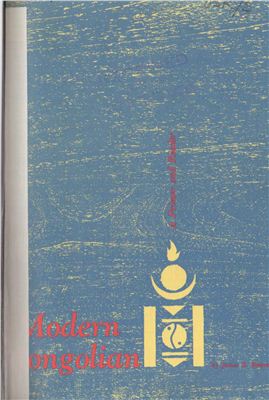Bosson J.E. Mode Mongolian. A Primer and Reader. - Bloomington:
Indiana University, 1964. - 256p.
This book has been designed to serve as a textbook for the person who wishes to get a reading knowledge of Mode Mongolian. A student whp has finished the lessons in this book should, with the aid of a dictionary, be able to read any current publication coming from the Mongolian People's Republic. For this purpose I have included in the book a comprehensive outline of the grammatical structure of the language and a selection of reading materials of varied content, intended to give a basic, but not too narrow vocabulary. These reading selections were chosen from sources such as folktales, mode short stories and historical essays. Political material has been avoided as much as possible, except for a few readings chosen specifically to introduce the student to the terminology and the often artificial syntax of this kind of writing.
Each of the first ten lessons has been supplied with an individual vocabulary of the words appearing in the reading selection. I have also added notes to all selections after lesson ten, explaining idiomatic expressions and difficult constructions. These notes have been numbered in the order in which they appear in the reading selection, but corresponding numbers have not been inserted in the text. If the student has difficulty with a phrase, he will automatically seek a note on the passage; if he needs no explanation, why divert him?
Punctuation as used by the Mongolian writer is largely a personal matter and I have, therefore, retained in most cases the punctuation of the original. I have edited some of the reading selections, but the last five selections are presented exactly as they were published. The first eight reading passages are taken mainly from the early lessons of A. R. Rinchine's excellent reader—with a great deal of rearrangement and editing to fit the introduction of the grammatical material in this book.
This book has been designed to serve as a textbook for the person who wishes to get a reading knowledge of Mode Mongolian. A student whp has finished the lessons in this book should, with the aid of a dictionary, be able to read any current publication coming from the Mongolian People's Republic. For this purpose I have included in the book a comprehensive outline of the grammatical structure of the language and a selection of reading materials of varied content, intended to give a basic, but not too narrow vocabulary. These reading selections were chosen from sources such as folktales, mode short stories and historical essays. Political material has been avoided as much as possible, except for a few readings chosen specifically to introduce the student to the terminology and the often artificial syntax of this kind of writing.
Each of the first ten lessons has been supplied with an individual vocabulary of the words appearing in the reading selection. I have also added notes to all selections after lesson ten, explaining idiomatic expressions and difficult constructions. These notes have been numbered in the order in which they appear in the reading selection, but corresponding numbers have not been inserted in the text. If the student has difficulty with a phrase, he will automatically seek a note on the passage; if he needs no explanation, why divert him?
Punctuation as used by the Mongolian writer is largely a personal matter and I have, therefore, retained in most cases the punctuation of the original. I have edited some of the reading selections, but the last five selections are presented exactly as they were published. The first eight reading passages are taken mainly from the early lessons of A. R. Rinchine's excellent reader—with a great deal of rearrangement and editing to fit the introduction of the grammatical material in this book.

